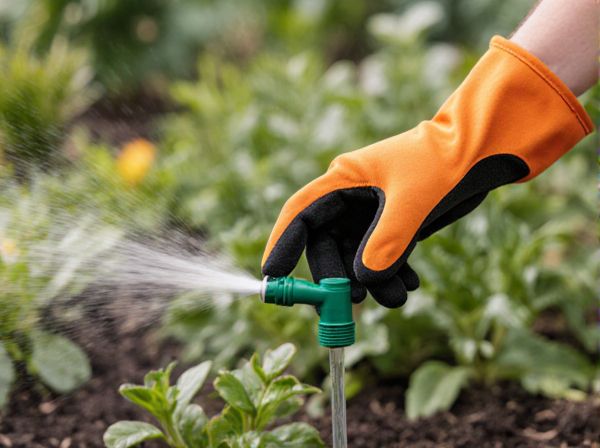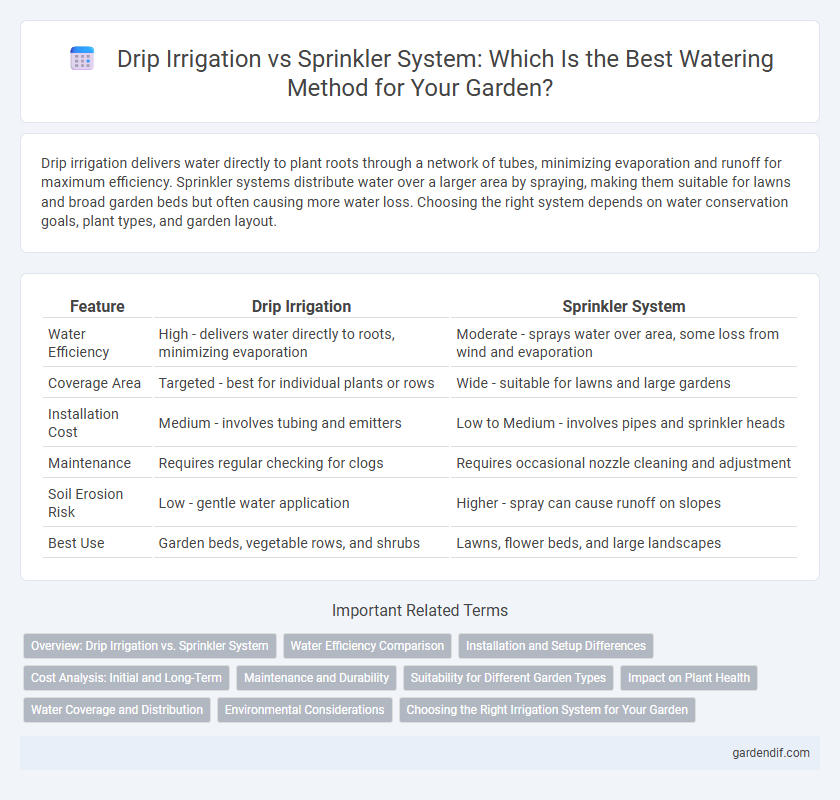
Drip irrigation vs Sprinkler system Illustration
Drip irrigation delivers water directly to plant roots through a network of tubes, minimizing evaporation and runoff for maximum efficiency. Sprinkler systems distribute water over a larger area by spraying, making them suitable for lawns and broad garden beds but often causing more water loss. Choosing the right system depends on water conservation goals, plant types, and garden layout.
Table of Comparison
| Feature | Drip Irrigation | Sprinkler System |
|---|---|---|
| Water Efficiency | High - delivers water directly to roots, minimizing evaporation | Moderate - sprays water over area, some loss from wind and evaporation |
| Coverage Area | Targeted - best for individual plants or rows | Wide - suitable for lawns and large gardens |
| Installation Cost | Medium - involves tubing and emitters | Low to Medium - involves pipes and sprinkler heads |
| Maintenance | Requires regular checking for clogs | Requires occasional nozzle cleaning and adjustment |
| Soil Erosion Risk | Low - gentle water application | Higher - spray can cause runoff on slopes |
| Best Use | Garden beds, vegetable rows, and shrubs | Lawns, flower beds, and large landscapes |
Overview: Drip Irrigation vs. Sprinkler System
Drip irrigation delivers water directly to the plant root zone through a network of tubes and emitters, minimizing evaporation and runoff, making it ideal for conserving water in arid regions. Sprinkler systems distribute water overhead in a spray, simulating natural rainfall, which is effective for lawns and large gardens but can lead to higher water loss due to evaporation and wind drift. Choosing between drip irrigation and sprinkler systems depends on factors such as crop type, soil conditions, water availability, and landscape size.
Water Efficiency Comparison
Drip irrigation delivers water directly to plant roots, reducing evaporation and runoff, resulting in water savings of up to 50% compared to sprinkler systems. Sprinkler systems often apply water uniformly over an area, causing higher evaporation losses and less efficient water use. Studies show drip irrigation can improve water use efficiency by maximizing soil moisture retention and minimizing waste.
Installation and Setup Differences
Drip irrigation systems require precise placement of tubing and emitters directly at the plant root zones, which involves more detailed initial layout and connection to a water source, often with pressure regulators and filters. Sprinkler systems are generally simpler to install with pop-up or fixed heads spread over a larger area, connected to standard garden hoses or underground piping requiring less intricate positioning. The setup of drip systems demands careful calibration to ensure even water delivery, whereas sprinklers operate on a broader spray pattern, making them easier to configure but less efficient for targeted watering.
Cost Analysis: Initial and Long-Term
Drip irrigation systems typically have higher initial costs due to specialized tubing and emitters but offer significant long-term savings through water efficiency and reduced labor. Sprinkler systems generally require lower upfront investment but incur higher ongoing expenses from water waste and maintenance. Over time, drip irrigation proves more cost-effective in arid regions where water conservation is critical.
Maintenance and Durability
Drip irrigation systems require minimal maintenance due to fewer moving parts and reduced clogging risks, making them more durable in sandy or hard water conditions. Sprinkler systems need regular inspections to clean nozzles and check for leaks, which can compromise durability over time. The longevity of drip systems typically surpasses sprinklers, especially in areas with water quality challenges or inconsistent pressure.
Suitability for Different Garden Types
Drip irrigation systems excel in gardens with diverse plant types and uneven terrain, delivering water directly to the root zone with minimal evaporation and runoff. Sprinkler systems are ideal for lawns and large, uniform areas where overhead watering can ensure even coverage. Selecting between drip irrigation and sprinklers depends largely on plant variety, garden size, and soil drainage characteristics to optimize water efficiency.
Impact on Plant Health
Drip irrigation delivers water directly to the root zone, minimizing water wastage and reducing the risk of fungal diseases by keeping foliage dry. Sprinkler systems provide broader coverage but can lead to leaf wetness, increasing susceptibility to leaf spot and mildew. Consistent moisture levels from drip irrigation promote deeper root growth and improved overall plant health compared to the variable wetting patterns of sprinklers.
Water Coverage and Distribution
Drip irrigation delivers water directly to the root zone of plants, ensuring precise water coverage with minimal evaporation and runoff, ideal for targeted watering in gardens and agricultural fields. Sprinkler systems provide broader water distribution, covering large areas uniformly but can lead to water loss through evaporation and wind drift. Efficiency in water usage is higher in drip irrigation due to controlled, slow release, whereas sprinklers are better suited for lawns and large plantings requiring uniform moisture.
Environmental Considerations
Drip irrigation significantly reduces water wastage by delivering water directly to plant roots, minimizing evaporation and runoff compared to sprinkler systems. Sprinkler systems often lead to higher water loss due to evaporation and drift, making them less efficient in arid or windy environments. Choosing drip irrigation supports sustainable water management and enhances soil moisture retention, reducing environmental impact.
Choosing the Right Irrigation System for Your Garden
Drip irrigation delivers water directly to plant roots with minimal evaporation, making it ideal for water conservation and targeting specific garden areas. Sprinkler systems cover larger areas uniformly, suitable for lawns and broad garden beds but often result in higher water loss due to evaporation and wind drift. Selecting the right irrigation system depends on garden size, plant type, water availability, and efficiency needs to ensure optimal growth and resource use.
Drip irrigation vs Sprinkler system Infographic

 gardendif.com
gardendif.com